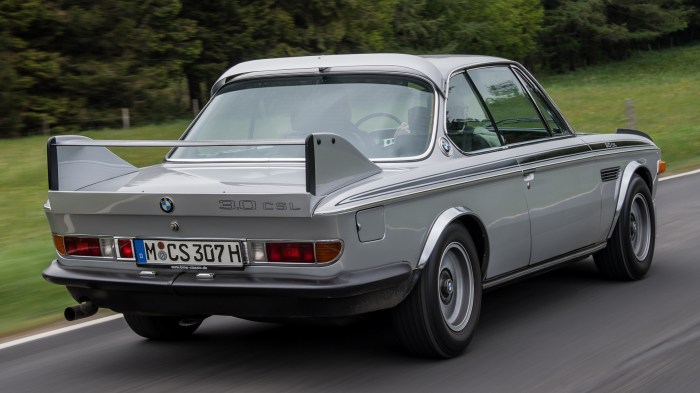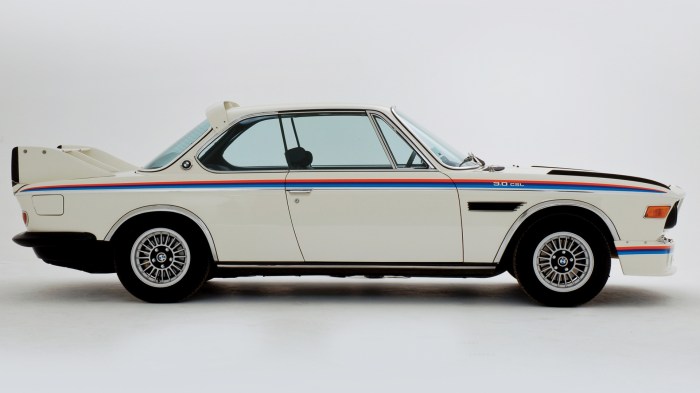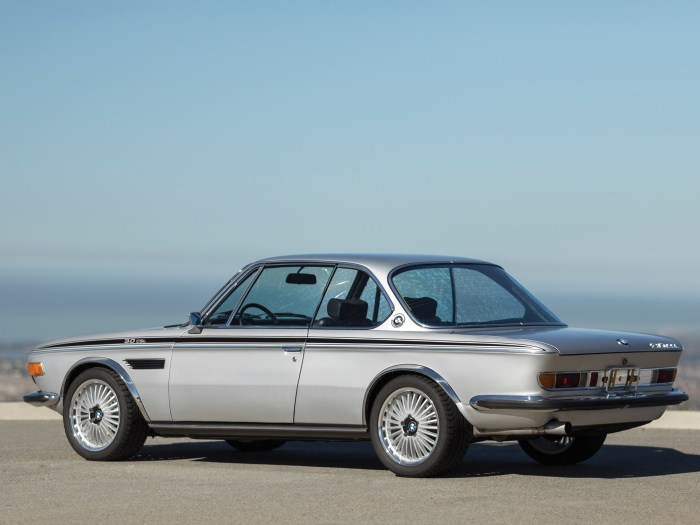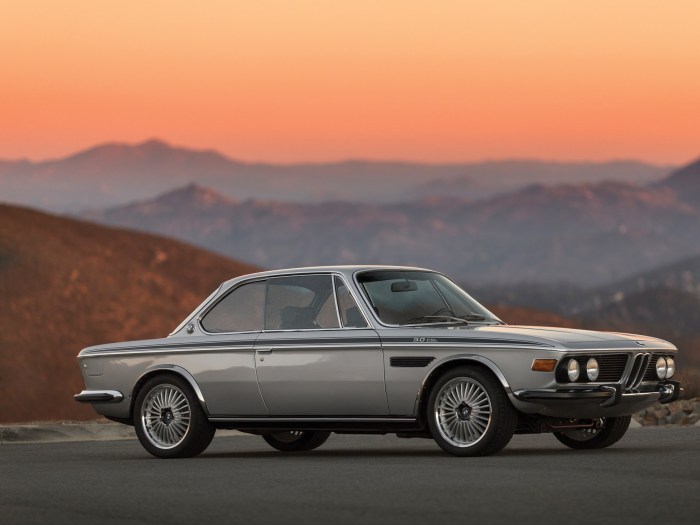The 1973 BMW 3.0CSL, a name synonymous with motorsport dominance and timeless design, stands as a testament to BMW’s engineering prowess and unwavering commitment to performance. This lightweight coupe, a homologation special designed for the European Touring Car Championship, became a legend on the track, leaving an indelible mark on the history of automotive racing.
Beyond its racing success, the 3.0CSL captured the hearts of enthusiasts with its striking aesthetics and groundbreaking technology. Its lightweight construction, aerodynamic bodywork, and powerful engine made it a force to be reckoned with, both on the racetrack and on the open road.
The 3.0CSL’s influence extends far beyond its era, inspiring future generations of BMW sports cars and leaving an enduring legacy in the world of automotive design.
Historical Context

The 1973 BMW 3.0 CSL, often referred to as the “Batmobile” due to its distinctive aerodynamic bodywork, holds a significant place in BMW’s history. It marked a turning point for the German automaker, solidifying its reputation as a builder of high-performance sports cars and establishing its presence in the world of motorsport.
The 3.0 CSL was not merely a road-going version of a race car; it was a purpose-built machine designed for the track and homologated for road use. This approach, common in the era of Group 2 touring car racing, saw manufacturers develop lightweight, highly tuned versions of their production cars for competition.
Role in Motorsport
The 3.0 CSL’s motorsport career was dominated by its success in the European Touring Car Championship (ETCC). This championship, known for its fierce competition and grueling races, provided the perfect proving ground for the 3.0 CSL. The car’s lightweight construction, powerful engine, and exceptional handling made it a formidable competitor.
BMW’s racing team, led by the legendary driver Jochen Neerpasch, quickly established the 3.0 CSL as a force to be reckoned with. The car won the ETCC championship in 1973 and 1975, cementing its legacy as one of the most successful touring cars of the era.The 3.0 CSL’s dominance in the ETCC was further amplified by its victories in numerous other races, including the 24 Hours of Spa, the 6 Hours of Watkins Glen, and the 12 Hours of Sebring.
The car’s success on the track contributed significantly to BMW’s burgeoning motorsport reputation, establishing the brand as a serious contender in international racing.
Comparison to Other Iconic Sports Cars
The 1973 BMW 3.0 CSL was a part of a golden age for sports car development. It competed directly with other iconic models, such as the Porsche 911, the Ferrari Dino 246 GT, and the Alfa Romeo Giulia GTA.
Each of these cars offered a unique blend of performance, style, and handling, but the 3.0 CSL stood out for its combination of lightweight construction, aerodynamic efficiency, and racing-derived technology.
The 3.0 CSL was a true driver’s car, offering a visceral experience that was unmatched by its rivals.
The 3.0 CSL’s distinctive bodywork, with its large rear wing and flared wheel arches, was not only visually striking but also essential for its performance on the track. This approach, focused on maximizing downforce and reducing drag, was a key factor in the car’s success in the ETCC.
The car’s lightweight construction, achieved through extensive use of aluminum and fiberglass, further enhanced its handling and acceleration.
Design and Engineering

The BMW 3.0 CSL was a masterpiece of automotive engineering, combining lightweight construction, aerodynamic bodywork, and a powerful engine to create a truly exceptional sports car. It was a testament to BMW’s commitment to motorsport and its ability to translate racing technology into road-going vehicles.
The 1973 BMW 3.0CSL, a homologation special built for racing, embodied the brand’s commitment to performance. Its sleek lines and powerful engine paved the way for future BMW models like the 1996 BMW 8 Series , a luxurious grand tourer that further pushed the boundaries of both performance and design.
The 3.0CSL’s legacy continues to inspire BMW’s pursuit of driving excellence, even in the face of today’s technologically advanced automobiles.
Lightweight Construction
The 3.0 CSL’s lightweight construction was crucial to its performance. BMW used extensive use of aluminum and fiberglass to reduce weight, resulting in a curb weight of just 2,400 pounds. The body panels were made of fiberglass, while the doors, hood, and trunk lid were made of aluminum.
The engine, suspension, and brakes were also designed for weight savings. The use of lightweight materials allowed the 3.0 CSL to achieve a remarkable power-to-weight ratio, contributing significantly to its exceptional handling and acceleration.
Aerodynamic Bodywork
The 3.0 CSL’s aerodynamic bodywork was another key factor in its performance. BMW’s engineers incorporated numerous design elements to reduce drag and improve downforce, including a large rear spoiler, a front air dam, and a smooth underbody. These features helped the 3.0 CSL achieve a top speed of over 150 mph and provided excellent stability at high speeds.
The 3.0 CSL’s aerodynamic design was groundbreaking for its time and set the stage for future high-performance cars.
Engine and Drivetrain
The 3.0 CSL was powered by a 3.0-liter inline-six engine that was continuously developed throughout its production run. The engine was initially rated at 200 horsepower but was later upgraded to produce 206 horsepower and then 240 horsepower in the final “Batmobile” version.
The engine featured a high-revving design, a dual-carburetor system, and a high-flow exhaust system, contributing to its impressive power output.The 3.0 CSL was equipped with a four-speed manual transmission and a limited-slip differential. The transmission was known for its smooth and precise shifting, while the limited-slip differential helped to improve traction and handling.
Performance Specifications
The 3.0 CSL’s performance specifications were exceptional for its time. The car could accelerate from 0 to 60 mph in just over 6 seconds and had a top speed of over 150 mph. Its handling was also praised for its precision and responsiveness.The 3.0 CSL’s performance was comparable to other high-performance sports cars of the era, such as the Porsche 911 and the Ferrari Dino 246.
However, the 3.0 CSL’s lightweight construction and aerodynamic bodywork gave it an edge in terms of handling and agility.
| Performance Specifications | BMW 3.0 CSL | Porsche 911 | Ferrari Dino 246 |
|---|---|---|---|
| Engine | 3.0-liter inline-six | 2.4-liter flat-six | 2.4-liter V6 |
| Power | 240 hp | 210 hp | 195 hp |
| Torque | 210 lb-ft | 177 lb-ft | 160 lb-ft |
| 0-60 mph | 6.2 seconds | 6.5 seconds | 7.0 seconds |
| Top Speed | 150 mph | 140 mph | 135 mph |
Production and Legacy

The BMW 3.0 CSL was a limited-production sports car, built in response to the growing popularity of touring car racing in the early 1970s. Its production was marked by a meticulous approach, a testament to BMW’s commitment to building a truly exceptional machine.
Production Process, 1973 BMW 3.0CSL
The 3.0 CSL’s production process was a blend of hand-crafted artistry and advanced engineering. Each car was assembled by a dedicated team of skilled technicians, who meticulously crafted the car’s lightweight body and powerful engine. This meticulous approach ensured that each 3.0 CSL was built to the highest standards of quality and performance.
Limited Production Run
The 3.0 CSL was produced in a limited run, with only 1,265 units built between 1971 and 1975. This limited production run contributed to the car’s exclusivity and desirability, further solidifying its status as a collector’s item.
Impact on BMW’s Image and Brand Identity
The 3.0 CSL’s success on the racetrack and its distinctive design played a significant role in shaping BMW’s image and brand identity. The car’s victories in prestigious races like the European Touring Car Championship and its iconic coupe silhouette established BMW as a leading manufacturer of high-performance sports cars.
The 3.0 CSL’s success also solidified BMW’s reputation for engineering excellence and innovative design.
Enduring Popularity and Influence
The 3.0 CSL’s enduring popularity is a testament to its timeless design and exceptional performance. It remains a highly sought-after collector’s car, with prices steadily rising over the years. The car’s influence on subsequent BMW models is evident in the design and engineering of later generations of the 3 Series and other BMW sports cars.
The 3.0 CSL’s lightweight construction, powerful engine, and aerodynamic design have served as inspiration for generations of BMW engineers, shaping the company’s commitment to building high-performance, driver-focused vehicles.
The 1973 BMW 3.0CSL, a homologation special built for Group 2 racing, was a further refinement of its predecessor, the 1972 BMW 3.0CSL. It featured a wider track, revised suspension, and a more powerful 3.2-liter engine, making it even more capable on the racetrack.
The 1973 model was also notable for its distinctive “batmobile” rear wing, which helped to improve downforce and stability at high speeds.
Collecting and Restoration

The 1973 BMW 3.0 CSL is a highly sought-after collector’s car, attracting enthusiasts and investors alike. Its racing heritage, sleek design, and limited production run make it a prized possession. Acquiring a genuine 3.0 CSL and maintaining its condition require careful consideration and expertise.
Authenticity and Identification
Authenticating a 1973 BMW 3.0 CSL is crucial to ensure its value and heritage. Distinguishing genuine cars from replicas can be challenging, as many skilled builders create convincing copies.
- Original Documents:A genuine 3.0 CSL will have original documents, including the factory build sheet, service records, and ownership history. These documents provide irrefutable evidence of the car’s authenticity.
- Chassis Number:The chassis number, located on the driver’s side firewall, should match the records. It’s important to note that the 3.0 CSL was built with both a chassis number and a separate engine number, making it more difficult to duplicate.
The 1973 BMW 3.0CSL, a legendary homologation special, exemplified the brand’s racing prowess, showcasing its commitment to lightweight performance. While the 3.0CSL was a track-focused machine, BMW also offered the more luxurious 1972 BMW Bavaria for those seeking a comfortable and refined driving experience.
Both cars, however, shared the same lineage of German engineering excellence, contributing to BMW’s reputation for producing exceptional automobiles.
- Unique Features:Genuine 3.0 CSLs possess unique features that are difficult to replicate. These include specific body panels, interior trim, and mechanical components. For example, the 3.0 CSL has a distinctive “ducktail” spoiler, wider wheel arches, and lightweight fiberglass doors. The interior features Recaro seats, a Momo steering wheel, and a unique dashboard design.
Furthermore, the engine and suspension components are specific to the 3.0 CSL and were not used on other BMW models.
- Expert Inspection:A thorough inspection by a reputable BMW specialist or vintage car expert is essential. They can identify subtle differences between a genuine 3.0 CSL and a replica, such as the quality of the paint, welds, and other details. A specialist can also verify the engine number and other components to ensure they are original.
Restoration and Maintenance
Restoring a 1973 BMW 3.0 CSL to its original condition is a challenging and rewarding endeavor. The car’s complexity, limited availability of parts, and the high demand for original components require a dedicated approach.
- Expertise:Restoring a 3.0 CSL requires the expertise of a skilled mechanic or restoration specialist with experience working on classic BMWs. Finding a specialist who understands the car’s unique features and can source original parts is crucial.
- Parts Sourcing:Finding original parts for a 3.0 CSL can be a challenge. Many parts are no longer in production, and those that are available can be expensive. There are specialized suppliers of BMW classic parts, as well as online forums and communities where collectors can find rare and sought-after components.
For example, some parts may be available from BMW Classic, the official BMW division that provides parts and support for vintage models. Other options include specialist restoration shops that specialize in sourcing parts for classic BMWs.
- Preservation:When restoring a 3.0 CSL, it’s important to preserve its original features and character. Using original parts whenever possible is essential to maintain the car’s authenticity and value. In some cases, restoration may involve using high-quality replicas or aftermarket parts that are indistinguishable from the originals.
For example, the fiberglass body panels, which are prone to cracking, may need to be replaced with replicas. However, it’s crucial to use replicas that are made to the highest standards and that closely match the original specifications.
- Documentation:Detailed documentation of the restoration process is essential. This includes photographs, receipts, and notes on the parts used and the work performed. This documentation helps to preserve the car’s history and provides evidence of its authenticity.
Value and Investment
The value of a 1973 BMW 3.0 CSL has been steadily increasing over the years, making it a desirable investment. However, the value of any collector car is influenced by several factors, including condition, authenticity, and market demand.
- Condition:The condition of a 3.0 CSL significantly affects its value. A car in original, unrestored condition is highly sought-after and commands a premium price. However, a well-restored car with documented history can also be valuable, especially if the restoration was done to the highest standards using original parts.
- Authenticity:As mentioned earlier, authenticity is crucial for a 3.0 CSL’s value. A car with verifiable documentation, original parts, and a history of proper maintenance will be more valuable than a replica or a car with questionable provenance.
- Market Demand:The demand for 3.0 CSLs fluctuates based on market conditions and interest from collectors. During periods of strong economic growth and increased interest in classic cars, the value of a 3.0 CSL may increase. However, during economic downturns or when interest in classic cars wanes, the value may decline.
Cultural Impact: 1973 BMW 3.0CSL

The BMW 3.0 CSL, with its striking design and exhilarating performance, transcended the realm of mere transportation, becoming a cultural icon. Its presence in popular culture, from films and television shows to video games, cemented its status as a symbol of speed, style, and automotive excellence.
The car’s enduring appeal is evident in its continued influence on modern sports car design and its enduring popularity among collectors and enthusiasts alike.
Notable Appearances
The 3.0 CSL’s appearances in popular culture have played a significant role in shaping its legacy. The car’s distinctive design and powerful performance have captivated audiences worldwide, making it a sought-after vehicle for filmmakers, television producers, and video game developers.
- The 3.0 CSL made its cinematic debut in the 1974 film “The Reincarnation of Peter Proud,” starring Michael Sarrazin. The car’s sleek lines and aggressive stance perfectly complemented the film’s suspenseful atmosphere, contributing to its overall aesthetic appeal. This appearance established the car as a symbol of luxury and performance, further solidifying its place in the public consciousness.
- The 3.0 CSL’s iconic status was further solidified by its appearance in the 1978 film “The Driver,” starring Ryan O’Neal. The car’s role as a getaway vehicle in this high-octane crime thriller showcased its handling prowess and powerful engine, making it a symbol of both speed and style.
The car’s dynamic performance and sleek design became synonymous with the film’s gritty and stylish aesthetic, further cementing its position as a cultural icon.
- In the 1980s, the 3.0 CSL’s popularity continued to grow with its appearance in the popular television series “Miami Vice.” The car’s distinctive design and bold color schemes perfectly complemented the show’s vibrant and stylish aesthetic. Its presence in the series, driven by characters such as Sonny Crockett, solidified its image as a symbol of luxury, sophistication, and power.
- The 3.0 CSL’s influence extended beyond film and television. In the 1990s, the car appeared in the popular video game “Gran Turismo,” further solidifying its status as a coveted and iconic sports car. The game’s realistic graphics and detailed simulations allowed players to experience the thrill of driving the 3.0 CSL, introducing a new generation to its legendary status.
Automotive Design Influence
The 3.0 CSL’s influence on automotive design is undeniable. Its lightweight construction, aerodynamic bodywork, and powerful engine have served as inspiration for generations of sports cars. The car’s distinctive design features, such as its wide wheel arches, prominent spoiler, and sleek lines, have been adopted and adapted by numerous manufacturers, shaping the aesthetic of modern sports cars.
“The 3.0 CSL was a revolutionary car for its time. It was a pioneer in lightweight construction and aerodynamic design, and it set a new standard for performance and handling. Its influence on future generations of sports cars is undeniable.”
BMW designer
The 3.0 CSL’s influence on modern sports car design can be seen in the lightweight construction and aerodynamic bodywork of vehicles like the Porsche 911 GT3 and the Ferrari 458 Italia. The car’s distinctive design features, such as its wide wheel arches and prominent spoiler, have been adopted and adapted by numerous manufacturers, shaping the aesthetic of modern sports cars.
Closing Notes

The 1973 BMW 3.0CSL remains a coveted collector’s item, a symbol of automotive excellence and a reminder of BMW’s commitment to pushing the boundaries of performance. Its legacy lives on in the DNA of modern BMW sports cars, a testament to its enduring impact on the automotive world.
The 3.0CSL stands as a timeless icon, a masterpiece of engineering and design that continues to captivate enthusiasts and inspire generations of drivers.